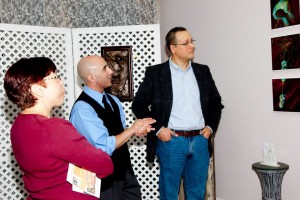 I honestly enjoy talking about my art, the process, the technique, the historical influences, and the possible story behind each piece. I believe that being able to explain your art is very important and increases credibility as an artist. I guess it applies to any craft. A while ago I posted something about this subject on twitter and it caused a little outrage from people who misunderstood “learning about your craft” with “going to school” and getting a formal education. Let me clarify that getting “formal” education is a good thing, but that’s not what I refer to. Leonardo di ser Piero da Vinci was autodidact. I guess that clarifies the point. It is not about formal education but to seek understanding about what you do and why because it helps you grow as an artist. If you can explain it, people will be more interested in what you do. This is what I suggest to aspiring artists:
I honestly enjoy talking about my art, the process, the technique, the historical influences, and the possible story behind each piece. I believe that being able to explain your art is very important and increases credibility as an artist. I guess it applies to any craft. A while ago I posted something about this subject on twitter and it caused a little outrage from people who misunderstood “learning about your craft” with “going to school” and getting a formal education. Let me clarify that getting “formal” education is a good thing, but that’s not what I refer to. Leonardo di ser Piero da Vinci was autodidact. I guess that clarifies the point. It is not about formal education but to seek understanding about what you do and why because it helps you grow as an artist. If you can explain it, people will be more interested in what you do. This is what I suggest to aspiring artists:
Find yourself in time
Newsflash!!! “There is nothing new under the sun“. This is at times an ego check to artists. You are only as unique as the variation and “spirit” you provide to your art. I suggest you look into an art history book and find yourself in time. All we do have an origin and an influence somewhere in the past. Get to know the arts that influence your art, and where your inspiration draws from. Don’t be intimidated by comparisons from artists from the past. That should be a compliment.
Assess your logic
No matter how “random” you think your art is, there must be a logic behind it. This logic can be found in the use of color, the strokes, rhythm, as it can be conceptual and philosophical. You can find this logic in every movement of art including modern art. Find your logic. When you do and explain it to people they will feel more involved with your work than you could imagine.
Assess your emotions
Maybe the explanation to your logic is found in what you feel when you are working. Art is a sensorial experience after all. Some people like to listen to a specific kind of music to get in a specific kind of mood. Anger, happiness, relaxation, tension, hope, sadness, loss, loneliness… there are many emotions that transpire in our work that if we can’t identify them someone would.
Now you can tell your story and provide the viewers with the “spirit” of the work and engage them even more. The more you immerse yourself in understanding your craft, the better you get at it, the more inspiration you find, the more engagement from your viewers you reach. Learn about other styles too, specially those that came before and after the one that identify yours. The more you know, the more your confidence as an artist will grow too. Educate yourself to explain your art.

Sachi
Dr Ivan Tirado
Ronald Boaks
Dr Ivan Tirado
Michelle Andres
Dr Ivan Tirado
Linda Friedman Schmidt
Nane (amalya nane Tumanian)
Dr Ivan Tirado
betsie molinsky
Dr Ivan
Pingback: A Tale of Two Sculptures - The Art of Ivan Tirado
Pingback: Let Art Speak - The Art of Ivan Tirado
Pingback: Intersubjective Artistic Matrix - The Art of Ivan Tirado